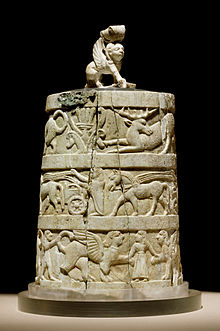Orientalizing period
The Orientalizing Period is a phase of Greek and Etruscan art that lasted from around 750 to 650 BC. Lasted. It is the first phase of Etruscan art. The term was coined by Frederik Poulsen to describe the phenomenon in Greek art. The term is also applied to the philosophy, religion, literature and myth of the Greeks.
Greece
Objects from the Orient appeared in large numbers in the 19th century, especially in Etruscan tombs. It was only later that numerous objects from the Middle East were found in Greece: bronze kettles, bronze figures, ivory carvings of furniture and faience, isolated in tombs, but above all in sanctuaries throughout the Aegean. These shrines include Olympia and Delphi , but also that of Hera on Samos or Athena of Lindos . It is uncertain who donated the objects to these temples. It may have been Greek traders who had traveled far and brought foreign objects with them. However, some consecrations may also come from foreigners. A large part of the dedications may, however, come from Greeks who acquired the exotic objects through trade.
Etruscan
Especially from about 750 to 650 BC. Luxury goods, but also ideas and knowledge from the Middle East and the Aegean Sea were exported to Etruria . The older research assumed that there were isolated imports in Etruria. The more recent research rather assumes that not only individual objects, but also ideas, a certain lifestyle and technologies were brought to Italy on a large scale. This may have something to do with the establishment of Greek colonies in southern Italy, which organized trade with the Orient. Oriental objects first appeared in Etruscan coastal cities such as Veii , Caere, and Tarquinia . Not only are there imported goods from the Orient, but Etruscan art production was also heavily influenced by the Orient. The first painted Etruscan burial chambers showed oriental influence. From around 650 BC. The oriental influence in Etruscan art decreased and was replaced by Greek influences.
See also
literature
- Walter Burkert : The orientalizing epoch in Greek religion and literature. Heidelberg 1984, ISBN 3-533-03528-X .
- Walter Burkert: Small writings II - Orientalia. Edited by Maria Laura Gemelli Marciano. Göttingen 2003, ISBN 978-3-525-25271-0 .
- Walter Burkert: The Greeks and the Orient. Munich 2004, ISBN 3-406-50247-4 .
- Ann C. Gunter: Beyond "Orientalizing": Encounters Among Cultures in the Eastern Mediterranean In: Joan Aruz, Sarah Graff, Yelena Rakic (Eds.): Assyria to Iberia: at the Dawn of the Classical Age. The Metropolitan Museum of Art, New York / New Haven 2014, ISBN 978-0-300-20808-5 , pp. 248-253.
- Martin L. West : Early Greek Philosophy and the Orient. Clarendon Press, Oxford 1971.
- Martin L. West: The East Face of Helicon: West Asiatic Elements in Greek Poetry and Myth. Clarendon Press, Oxford 1997, ISBN 0-19-815042-3 .
Individual evidence
- ↑ The Orient and Early Greek Art , Leipzig 1912
- ↑ Ann C. Gunter: Beyond "Orientalizing": Encounters Among Cultures in the Eastern Mediterranean In: Joan Aruz, Sarah Graff, Yelena Rakic (eds.): Assyria to Iberia: at the Dawn of the Classical Age. The Metropolitan Museum of Art, New York / New Haven 2014, ISBN 978-0-300-20808-5 , p. 251.
- ↑ Maurizio Sannibale: Laventine and Orientalizing Luxury Goods from Etruscan Tombs In: Joan Aruz, Sarah Graff, Yelena Rakic (eds.): Assyria to Iberia: at the Dawn of the Classical Age. The Metropolitan Museum of Art, New York / New Haven 2014, ISBN 978-0-300-20808-5 , pp. 313-314.
